 |
DEPARTMENT RESULTS |
|
|
| |
|
Goal:
Assure that benefits are delivered to injured workers quickly, efficiently,
and at a reasonable cost to employers |
|
Why
is this goal important?
The Minnesota workers’ compensation system represents an agreement between
workers and employers to operate a no-fault system for providing benefits to
injured workers. The success of the system requires that it be fast,
responsive and easy to use. The system must be efficient to assure prompt
delivery of services, optimal use of resources and minimal disputes. For the
system to be effective: workers, employers and providers need to comply with
the law and rules; strong workplace safety programs should set the stage for
reduced injuries and illnesses; and workers and employers must be satisfied
that the system is responsive, easy to access and fair to all parties.
What
is the department's progress to date?
In 2006, 87 percent of the filed lost-time claims were paid or denied within
the statutory 14-day deadline. This is from a base of approximately 29,000 claims. DLI
aims to increase statutory compliance to 95 percent by 2010. Comprehensive training and
auditing of insurers and self-insured employers, to explain the requirements
and to facilitate timely action, have led to improvements.
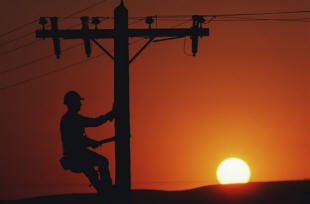 |
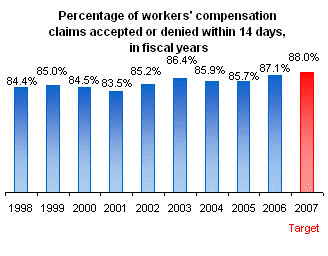 |
DLI’s dispute resolution process offers a full range of
alternative dispute resolution strategies, beginning with a customer
assistance approach to dispute prevention and continuing with an informal
mediation-arbitration option. The department’s toll-free “hotline” number
connects callers to experienced specialists who are able to achieve real-time resolutions
using state-of-the-art telecommunication and
computer imaging technology. Instant access to the complete imaged file
enables specialists to quickly diagnose the source of problems
and make the necessary calls to solve them. If a solution is not
reached, an informal administrative conference may be scheduled or, if the
parties agree, a mediation session may be arranged, which often
leads to a full, final and complete claim settlement.
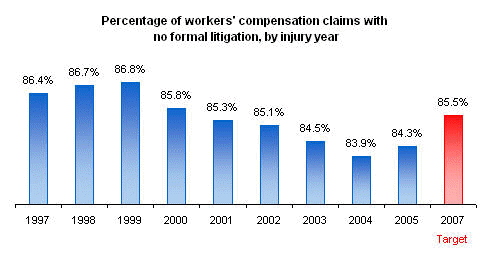
The administrative expenses of the system include the
operational costs for the DLI Workers’ Compensation Division, Minnesota OSHA,
the Workers’ Compensation Court of Appeals
and portions of the Department of Commerce and the Office of Administrative
Hearings. The system cost reached a peak in
1995 of 4.9 cents per $100 of payroll and dropped to a low of 3.2 cents in 2004 – a
35 percent decline.
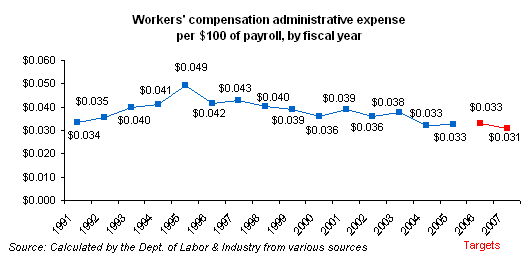
A survey conducted in 2004 shows that 59 percent of injured workers and 62
percent of
employers were satisfied with their overall workers’ compensation
experience. The area of greatest concern for employers was insurance costs,
whereas injured workers were most concerned about relations with their
employer’s insurance company. DLI will conduct this same survey in
2007/2008 to measure our progress.
|
|
Goal: Improve workplace
safety and health |
|
Why
is this goal important?
Every Minnesota worker has the right to return home safe and healthy each
day. Yet each month, approximately 8,700 Minnesota employees are hurt at work and five workers die on the job.
The emotional and fiscal impact to families and employers when employees die
or are hurt on the job is a threat to the financial stability of families,
employers, co-workers and the state as a whole.
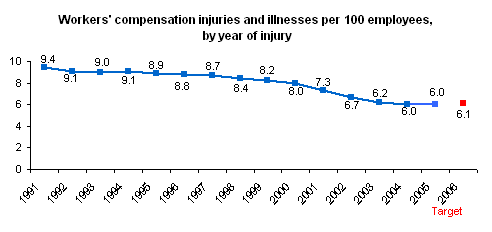
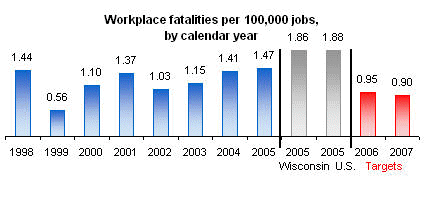 Workplace
safety is directly addressed through the work of two DLI units that
administer the Minnesota Occupational Safety and Health Act (OSHA). The OSHA
Compliance unit and Workplace Safety Consultation unit work with employers
and employees to reduce the number of fatalities, injuries and illnesses in
Minnesota's workplaces. Workplace
safety is directly addressed through the work of two DLI units that
administer the Minnesota Occupational Safety and Health Act (OSHA). The OSHA
Compliance unit and Workplace Safety Consultation unit work with employers
and employees to reduce the number of fatalities, injuries and illnesses in
Minnesota's workplaces.
|
|
How
will this goal be accomplished?
Minnesota OSHA Compliance conducts random and unannounced workplace
inspections. It issues citations that require employers with significant
violations to pay penalties and correct hazards. Workplace Safety
Consultation conducts on-site visits at the request of employers and does
not issue penalties, but works with employers to correct hazards. Employers
can request this free service to help identify and resolve safety and health
problems.
Minnesota's OSHA programs established a
five-year strategic plan starting in 2004 with the following goals:
 reduce occupational hazards through enforcement inspections and on-site
consultation
reduce occupational hazards through enforcement inspections and on-site
consultation
visits;
 promote a safety and health culture through compliance assistance, outreach,
promote a safety and health culture through compliance assistance, outreach,
cooperative programs, and strong leadership; and
 strengthen and improve its infrastructure.
strengthen and improve its infrastructure.
Minnesota
OSHA focuses efforts on employers in a set of emphasis industries. Minnesota OSHA
responds to information requests and provides
outreach throughout the state. Minnesota OSHA has established voluntary
cooperative agreements and partnerships to facilitate employer and employee
involvement to improve workplace safety and health.
Construction safety is a major focus for
inspection, consultation and outreach efforts. The majority of planned
safety inspections were conducted at construction worksites. Construction
safety breakfasts are organized to disseminate new safety and health
information to the industry. Minnesota OSHA and Associated General
Contractors of Minnesota agreed to a major construction safety-initiative --
Construction Health and Safety Excellence (CHASE) Minnesota -- in 2003. The
partnership charter acknowledges the importance of providing a safe,
healthful work environment in construction and seeks a working relationship
that creates mutual trust and respect among all parties, including project
owners and construction workers, invoiced in the construction process.

|
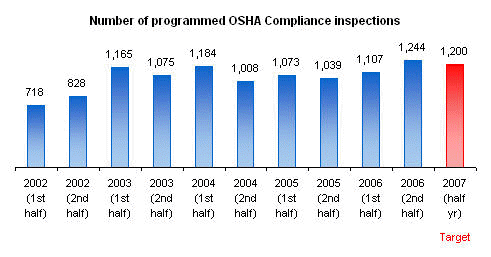 |
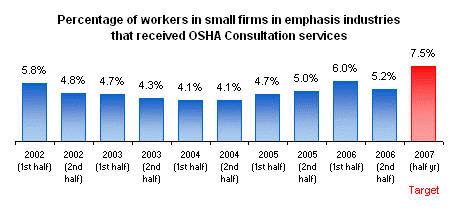 The MNSTAR and MNSHARP
programs administered by the Workplace Safety Consultation recognize companies where managers and employees work together to
develop safety and health management systems that go beyond basic compliance
with all applicable OSHA standards. This results in immediate and long-term
prevention of job-related injuries and illnesses. Currently, there are 22
employers enrolled in MNSTAR, which is modeled after the federal OSHA
Voluntary Protection Program. MNSHARP offers safety recognition for small
employers, with 29 employers currently enrolled. Key elements of these
programs include: management leadership and employee
involvement; a worksite analysis; systems that identify and control
workplace hazards; and a plan for employee safety and health training and
education. Incentives for participant companies include safety consultation assistance,
public recognition, and exemption from Minnesota OSHA Compliance scheduled inspections.
Workplace Safety Consultation also provides assistance toward workplace
violence prevention and logger safety. The MNSTAR and MNSHARP
programs administered by the Workplace Safety Consultation recognize companies where managers and employees work together to
develop safety and health management systems that go beyond basic compliance
with all applicable OSHA standards. This results in immediate and long-term
prevention of job-related injuries and illnesses. Currently, there are 22
employers enrolled in MNSTAR, which is modeled after the federal OSHA
Voluntary Protection Program. MNSHARP offers safety recognition for small
employers, with 29 employers currently enrolled. Key elements of these
programs include: management leadership and employee
involvement; a worksite analysis; systems that identify and control
workplace hazards; and a plan for employee safety and health training and
education. Incentives for participant companies include safety consultation assistance,
public recognition, and exemption from Minnesota OSHA Compliance scheduled inspections.
Workplace Safety Consultation also provides assistance toward workplace
violence prevention and logger safety.
 |
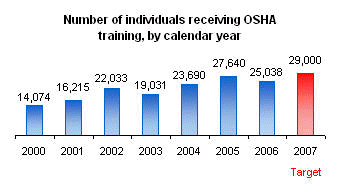 |
Minnesota OSHA works with trade associations to establish
partnerships. The goal is to work together with
employers and employees to help develop a strong commitment to safety and
health. Upon achieving certain safety and health performance expectations,
participants are provided recognition, penalty credits and, in some cases,
exemption from Minnesota OSHA Compliance scheduled inspections.
The Safety Grant Program awards up to $10,000 to qualifying employers for projects designed to reduce the risk of injury and
illness to workers. Priority is given to industrial employers or locations
where jobs have been lost or are jeopardized because of problems related to
safety or health shortcomings.
|
|
What
is the department's progress to date?
 OSHA Compliance visited 2,593 establishments and
identified 4,968 hazards during the OSHA Compliance visited 2,593 establishments and
identified 4,968 hazards during the
Oct. 2005-Sept. 2006 period.
 Workplace Safety
Consultation conducted 946 initial safety and health worksite visits Workplace Safety
Consultation conducted 946 initial safety and health worksite visits
and
held 332 training interventions during the Oct. 2005-Sept. 2006 period. The
visits
identified hazards that would have resulted in $4.0 million in OSHA
violation penalties.
 Five construction safety breakfasts were held during
2006, with 532 construction
Five construction safety breakfasts were held during
2006, with 532 construction
managers and supervisors in attendance, a 9
percent increase from the previous year.
 The number of people attending OSHA training increased
from about 14,000 in 2000 to
The number of people attending OSHA training increased
from about 14,000 in 2000 to
over 25,000 in 2006.
 Workplace injury and illness rates decreased from 6.8 per
100 full-time equivalent
Workplace injury and illness rates decreased from 6.8 per
100 full-time equivalent
workers in 2000 to 5.1 per 100 full-time equivalent
workers in 2005, a 25 percent
decline. |
| |
|
Goal:
Efficiently and
effectively promote safe and healthy work and living spaces in Minnesota |
|
Why
is this goal important?
Building codes are designed to save lives, reduce injuries and protect the
health of people in their everyday lives, at work, at home and in the
buildings they frequent. By reducing risk and making buildings safe we
prevent the undue economic loss that disaster, injury, loss of life and
property present.
Building codes in the U.S. have made the U.S. the safest place in the world
in which to survive an earthquake. The Loma Prieta earthquake in 1989, for
example, took 67 lives and caused an estimated $6-10 billion damage in the
San Francisco region, while a similar-sized earthquake in Armenia took
25,000-30,000 lives in 1988 and turned many cities and villages into
wastelands that persist today. While Minnesota is not an active seismic
area, we have tornadoes, snow loads, floods and a cold climate. Building
codes in Minnesota address these critical areas and more.
It is particularly important to verify proper code compliance during
construction of "institutional" buildings where the ability of the occupants
to provide for their own safety is very difficult. These include public
schools, hospitals, nursing homes, and correctional facilities. Because of
the higher risk associated with housing these types of people together and
the complexity of the regulations governing construction, the legislature
has conferred this responsibility onto agency staff.
The types of areas regulated by the Building Code for these and all building
types constructed in Minnesota addresses minimum construction standards for:
·
structural stability
·
fire protection
·
safe exiting
·
energy conservation
·
durability
·
accessibility
·
water and sewage services
·
electrical systems
·
mechanical systems
·
high pressure piping
|
|
How
will this goal be accomplished?
The Construction Codes and Licensing Division (CCLD)
is a newly-formed division of DLI with a mission to assure quality
construction, operation and maintenance of structures and their related
systems (plumbing, heating, electricity, etc.) in Minnesota. The division is
a consolidation of the Building Codes and Standards Division of the
Department of Administration, the Plumbing and Engineering Unit of the
Department of Health, the Board of Electricity, the Residential Contractors'
Licensing Unit of the Department of Commerce and the Boiler and
High-Pressure Piping Unit of DLI. The consolidation is resulting in
streamlined state processes for code regulation, construction licensing, and
industry compliance monitoring and allows design professionals, contractors
and other construction industry parties to interact with a single entity
regarding state building regulations.
The division administers the licensing of building professionals and
contracting firms, helping to create safer, more qualified practitioners,
which results in higher-quality construction and fewer consumer complaints.
The division also provides training to construction professionals and
contractors to keep practitioners current in the construction codes and to
keep Minnesota a safe place to live and work.
|
|
What
is the department's progress to date?
 Licensing of over 100,000 construction-related
specialists. These licenses include
Licensing of over 100,000 construction-related
specialists. These licenses include
electrical, plumbing, boiler, high
pressure piping, residential contractors, remodelers,
roofers, building
officials and accessibility specialists.
 Providing high quality construction code education and
training for over 7,000 industry
Providing high quality construction code education and
training for over 7,000 industry
professionals. Classes focus on all code
subject matter including energy, mechanical,
plumbing, boiler, electrical,
manufactured structures, accessibility, structural, general
construction and
fire safety. The primary audiences for these classes are architects,
engineers, code officials, contractors, material suppliers and students
preparing for a
career in the construction industry.
 Conducting over 3,000 plan reviews for plumbing systems
and major construction plans
Conducting over 3,000 plan reviews for plumbing systems
and major construction plans
for facilities that are 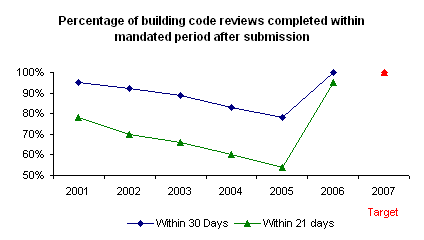 state-owned, -funded or
-licensed, including school district projects state-owned, -funded or
-licensed, including school district projects
over $100,000. In order to
keep the delay of state
facility construction to a
minimum and to assist in
getting them ready for
occupancy in
as short as
time as possible,
particularly with our
shortened
construction
season, the division
offers
services to
keep the plan review
process as brief and
efficient as
possible. In
accordance with a legislative requirement, all plan reviews must be
completed within the
30 days of receiving a
completed application. The division takes that a step further by
imposing a standard
of completing reviews within 21 days.
 Conducting approximately 400,000 separate inspections on
200,000 separate Conducting approximately 400,000 separate inspections on
200,000 separate
installations annually. The division is working to identify
common aspects of the
inspection programs for boilers, pressure vessels,
boats for hire, and hobby boilers;
elevators and escalators; high pressure
piping installations; and electrical installation to
develop platforms that
take advantage of the commonalities in inspections, licensing and
other
department activities.
 During 2007, the CCLD will perform recertification
inspections of over 2,000 bleachers, During 2007, the CCLD will perform recertification
inspections of over 2,000 bleachers,
in accordance with Minnesota's Bleacher
Safety Act. The goal is to eliminate bleacher
failures through good
inspections, responsiveness to complaints and bleacher safety
education.
The CCLD is exploring technology upgrades that will allow the division to
further streamline its processes and improve service delivery to the
construction industry. The licensing function is a top priority and where
service delivery improvements will be the most beneficial.
|
|
Last update on
07/27/2007 |
|







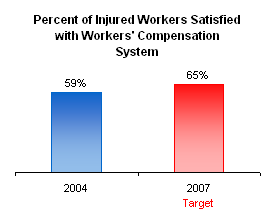
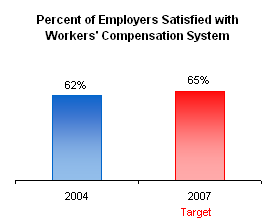

 Workplace
safety is directly addressed through the work of two DLI units that
administer the Minnesota Occupational Safety and Health Act (OSHA). The OSHA
Compliance unit and Workplace Safety Consultation unit work with employers
and employees to reduce the number of fatalities, injuries and illnesses in
Minnesota's workplaces.
Workplace
safety is directly addressed through the work of two DLI units that
administer the Minnesota Occupational Safety and Health Act (OSHA). The OSHA
Compliance unit and Workplace Safety Consultation unit work with employers
and employees to reduce the number of fatalities, injuries and illnesses in
Minnesota's workplaces.

 The MNSTAR and MNSHARP
programs administered by the Workplace Safety Consultation recognize companies where managers and employees work together to
develop safety and health management systems that go beyond basic compliance
with all applicable OSHA standards. This results in immediate and long-term
prevention of job-related injuries and illnesses. Currently, there are 22
employers enrolled in MNSTAR, which is modeled after the federal OSHA
Voluntary Protection Program. MNSHARP offers safety recognition for small
employers, with 29 employers currently enrolled. Key elements of these
programs include: management leadership and employee
involvement; a worksite analysis; systems that identify and control
workplace hazards; and a plan for employee safety and health training and
education. Incentives for participant companies include safety consultation assistance,
public recognition, and exemption from Minnesota OSHA Compliance scheduled inspections.
Workplace Safety Consultation also provides assistance toward workplace
violence prevention and logger safety.
The MNSTAR and MNSHARP
programs administered by the Workplace Safety Consultation recognize companies where managers and employees work together to
develop safety and health management systems that go beyond basic compliance
with all applicable OSHA standards. This results in immediate and long-term
prevention of job-related injuries and illnesses. Currently, there are 22
employers enrolled in MNSTAR, which is modeled after the federal OSHA
Voluntary Protection Program. MNSHARP offers safety recognition for small
employers, with 29 employers currently enrolled. Key elements of these
programs include: management leadership and employee
involvement; a worksite analysis; systems that identify and control
workplace hazards; and a plan for employee safety and health training and
education. Incentives for participant companies include safety consultation assistance,
public recognition, and exemption from Minnesota OSHA Compliance scheduled inspections.
Workplace Safety Consultation also provides assistance toward workplace
violence prevention and logger safety.

 state-owned, -funded or
-licensed, including school district projects
state-owned, -funded or
-licensed, including school district projects